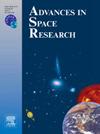跟踪近地小行星的近距离接近:2023 DZ2, 2018 UY和2024 ON由南半球小行星研究联盟
IF 2.8
3区 地球科学
Q2 ASTRONOMY & ASTROPHYSICS
引用次数: 0
摘要
我们概述了澳大利亚合作观测和描述近地小行星的能力,重点是其向澳大利亚西海岸的地理扩展。西海岸节点由西澳大利亚大学支持,使用Zadko天文台,配备了几架专门用于空间态势感知和行星防御的光学望远镜。我们报告了过去两年在近距离接近中选定的三颗小行星的观测结果:2023 DZ2, 2018 UY和2024 ON。对于2023 DZ2,我们证明,尽管光度条件变化很大,但有可能提取小行星的旋转特征。我们的分析得出了6.2770±0.0450分钟的旋转周期。2018年UY的近距离接近为以前未知的旋转提供了高质量的光度数据,我们估计其完整旋转的一半为4.2759±0.3037小时。我们的分析揭示了一个显著的周期性星等变化(Δm≈1),表明小行星被高度拉长。假设一个三轴椭球模型,我们估计其延伸率的上限约为其宽度的2.5倍。最后,2024 ON可能是一个接触双星系统,于2024年7月27日被美国宇航局位于夏威夷莫纳罗亚的阿特拉斯系统发现。我们提供了高质量的光度数据,潜在地证实了该系统的双星性质,估计半旋转周期为2.9789±0.1363小时。本文章由计算机程序翻译,如有差异,请以英文原文为准。
Tracking Near-Earth Asteroids’ close approaches: 2023 DZ2, 2018 UY, and 2024 ON by the Southern Hemisphere Asteroid Research Consortium
We present an overview of the capabilities of the Australian collaboration for observing and characterising Near Earth Asteroids, with a focus on its geographic expansion to the West Coast of Australia. The West Coast node, supported by the University of Western Australia, uses the Zadko Observatory, equipped with several optical telescopes dedicated to Space Situational Awareness and Planetary Defence. We report observations of three selected asteroids during close approaches in the past two years: 2023 DZ2, 2018 UY, and 2024 ON. For 2023 DZ2, we demonstrate that despite highly variable photometric conditions, it is possible to extract the asteroid’s rotational signatures. Our analysis yields a rotational period of 6.2770 0.0450 min. The close approach of 2018 UY provided high-quality photometric data for a body with a previously unknown rotation, which we estimate to be 4.2759 0.3037 h for half of its full rotation. Our analysis reveals a significant periodic magnitude variation of (), indicating that the asteroid is highly elongated. Assuming a triaxial ellipsoid model, we estimate an upper limit for its elongation to be approximately 2.5 times longer than it is wide. Lastly, 2024 ON, likely a contact binary system, was discovered by NASA’s ATLAS system at Mauna Loa, Hawaii, on July 27, 2024. We present high-quality photometric data, potentially confirming the binary nature of this system with an estimated half-rotation period of 2.9789 0.1363 h.
求助全文
通过发布文献求助,成功后即可免费获取论文全文。
去求助
来源期刊

Advances in Space Research
地学天文-地球科学综合
CiteScore
5.20
自引率
11.50%
发文量
800
审稿时长
5.8 months
期刊介绍:
The COSPAR publication Advances in Space Research (ASR) is an open journal covering all areas of space research including: space studies of the Earth''s surface, meteorology, climate, the Earth-Moon system, planets and small bodies of the solar system, upper atmospheres, ionospheres and magnetospheres of the Earth and planets including reference atmospheres, space plasmas in the solar system, astrophysics from space, materials sciences in space, fundamental physics in space, space debris, space weather, Earth observations of space phenomena, etc.
NB: Please note that manuscripts related to life sciences as related to space are no more accepted for submission to Advances in Space Research. Such manuscripts should now be submitted to the new COSPAR Journal Life Sciences in Space Research (LSSR).
All submissions are reviewed by two scientists in the field. COSPAR is an interdisciplinary scientific organization concerned with the progress of space research on an international scale. Operating under the rules of ICSU, COSPAR ignores political considerations and considers all questions solely from the scientific viewpoint.
 求助内容:
求助内容: 应助结果提醒方式:
应助结果提醒方式:


